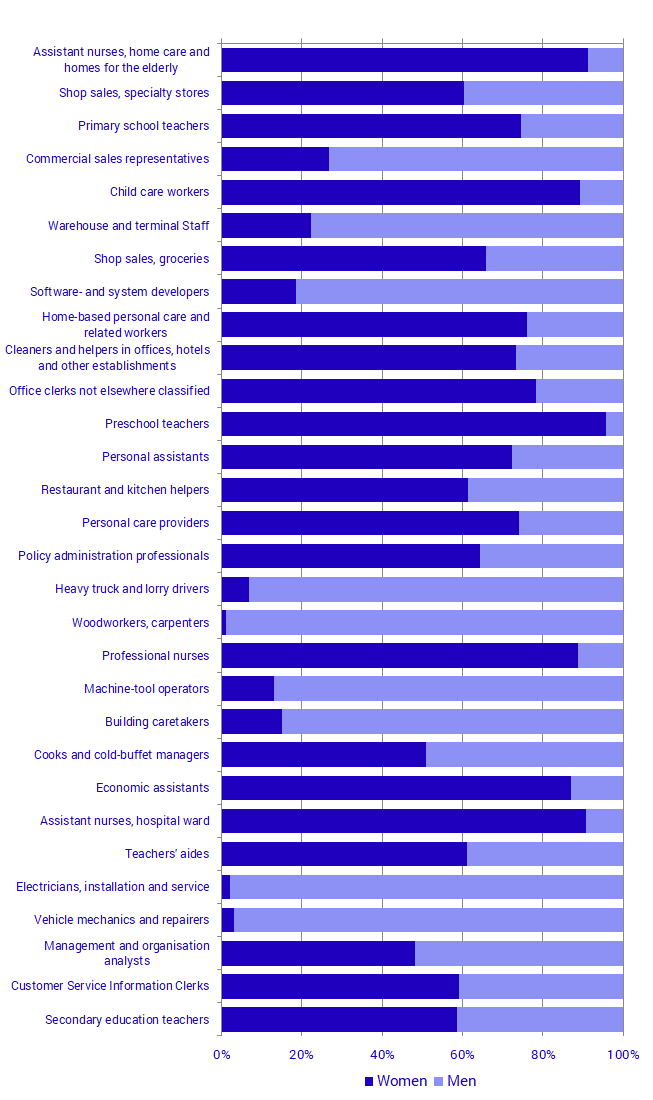The Swedish Occupational Register with statistics 2018
The most common occupation in Sweden was “assistant nurses, personal care, home care and homes for the elderly”.
Statistical news from Statistics Sweden 2020-03-05 9.30
The most common occupation in Sweden was “assistant nurses, personal care, home care and homes for the elderly”. There were 91 percent women and 9 percent men in this occupation. It was also the most common occupation among women. The most common occupation among men was “warehouse and terminal staff”, which was the sixth most common occupation in total. There were 78 percent men and 22 percent women in this occupation.
In the 30 most popular occupations, gender distribution was most evenly balanced among cooks and cold-buffet managers, with 51 percent women and 49 percent men. Even gender balance refers to a gender distribution of 40 percent and 60 percent respectively.

The most common occupation among foreign born persons was “cleaners”; 45 090 foreign born persons were cleaners. The occupation with the largest percentage of foreign born persons was “pizza makers”, which was also the occupation with the largest percentage, 89 percent, of foreign born men. “Other home-based personal care workers” was the occupation with the largest percentage, 67 percent, of foreign born women. The second most common occupation among foreign born women was “cleaners”, at 56 percent. Among employees aged 16–64 years, foreign born persons accounted for 18 percent.
| Occupation1) | Total | Number of native born | Number of foreign born | Foreign born, percent |
|---|---|---|---|---|
|
Pizza makers and fast food preparers
|
4 060 | 860 | 3 200 | 79 |
|
Maid, nanny and related workers
|
3 770 | 1 220 | 2 550 | 68 |
|
Cleaners and helpers in offices, hotels and other establishments
|
74 800 | 29 710 | 45 090 | 60 |
|
Translators, interpreters and other linguists
|
2 740 | 1 290 | 1 450 | 53 |
|
PhD Students
|
9 770 | 4 720 | 5 060 | 52 |
|
Bus and tram drivers
|
23 910 | 11 710 | 12 200 | 51 |
|
Machine operators, bleaching, dyeing and cleaning
|
2 990 | 1 520 | 1 470 | 49 |
|
Taxi, car, and van drivers
|
11 060 | 5 640 | 5 410 | 49 |
|
Choreographers and dancers
|
370 | 200 | 170 | 47 |
|
Beauty and body therapists professionals not elsewhere classified
|
1 110 | 590 | 510 | 46 |
|
Butchers, fishmongers and related food preparers
|
3 260 | 1 800 | 1 460 | 45 |
|
Research assistants
|
2 930 | 1 630 | 1 310 | 45 |
|
Machine operators, meat- and fish-processing
|
4 600 | 2 580 | 2 020 | 44 |
|
Restaurant and kitchen helpers
|
68 150 | 39 250 | 28 910 | 42 |
|
Leaflet and newspaper distributors
|
6 520 | 3 790 | 2 730 | 42 |
|
Total
|
4 345 500 | 3 552 700 | 792 900 | 18 |
1) According to the Swedish Standard Classification of Occupations 2012 (SSYK2012) at a four-digit level. Total number of persons with occupational data. The figures are rounded to the nearest 10.
Definitions and explanations
Information concerning employees is reported for those aged 16-64 years classified as gainfully employed in the register-based labour market statistics (RAMS). Classification of gainfully employed persons is based mainly on statements of earnings and tax declaration information from the Swedish Tax Agency. To be classified as gainfully employed, the person must have a salary income that exceeds an estimated threshold or operate business activities. In addition, the person must be entered in the population register in Sweden on 31 December and be between 16 and 74 years old. Even those who were temporarily absent during the measurement period, for instance due to sickness or parental leave, are included in the frame. The term ‘employee’ also includes self-employed persons who run their operations as a limited company.
The occupations follow the classifications used in the Swedish Standard Classification of Occupations (SSYK 2012).
Publication
A more detailed report on this survey is published in the Statistical Report:
Next publishing will be
The next statistical news in this series will be published in March 2021.
Statistical Database
More information is available in the Statistical Database
Feel free to use the facts from this statistical news but remember to state Source: Statistics Sweden.
